九年级unit5reading说课稿
- 格式:doc
- 大小:119.00 KB
- 文档页数:3

人教版英语九年级Unit 5《What are the shirts made of》全单元说课稿一. 教材分析人教版英语九年级Unit 5《What are the shirts made of》主要围绕衣服的材质展开,通过学习本单元,学生能够掌握询问和描述衣服材质的交际能力。
本单元关键词包括:material, shirt, made of, cotton, wool, synthetic等。
课文内容丰富,插图清晰,旨在激发学生的学习兴趣,提高他们的语言运用能力。
二. 学情分析九年级的学生已经掌握了基本的英语语法和词汇,具备一定的听说读写能力。
但部分学生在实际运用英语进行交流时,仍存在一定的困难。
针对这一情况,教师应关注学生的个体差异,充分调动他们的学习积极性,提高他们的语言运用能力。
三. 说教学目标1.知识目标:学生能够掌握本单元关键词汇,理解课文内容,了解衣服材质的相关知识。
2.能力目标:学生能够运用所学知识进行询问和描述衣服材质的交际活动。
3.情感目标:培养学生热爱生活,关注服饰文化的态度。
四. 说教学重难点1.重点:掌握本单元关键词汇,理解课文内容。
2.难点:运用所学知识进行实际交际,提高语言运用能力。
五. 说教学方法与手段1.交际法:通过模拟真实场景,让学生在实际交际中运用所学知识。
2.任务型教学法:引导学生参与各种实践活动,提高他们的语言运用能力。
3.多媒体辅助教学:运用多媒体课件、图片等教学资源,丰富教学手段,激发学生的学习兴趣。
六. 说教学过程1.导入:以衣服为主题的图片或视频导入,激发学生的学习兴趣。
2.新课展示:讲解课文内容,让学生了解衣服材质的相关知识。
3.实践环节:模拟真实场景,让学生进行衣服材质的询问和描述交际活动。
4.巩固环节:通过小组讨论、游戏等形式,巩固所学知识。
5.拓展环节:引导学生关注服饰文化,培养他们的审美情趣。
6.总结:对本节课内容进行总结,布置作业。
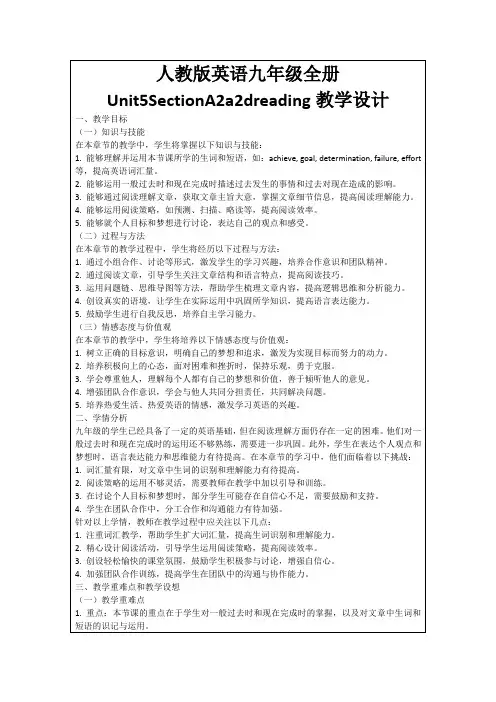
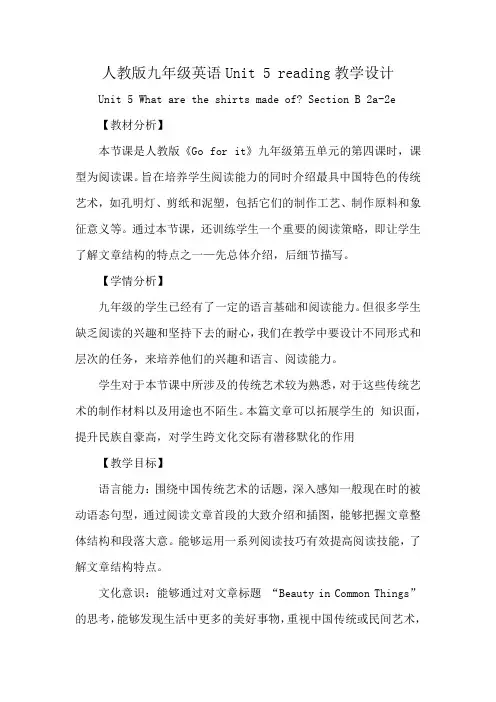
人教版九年级英语Unit 5 reading教学设计Unit 5 What are the shirts made of? Section B 2a-2e【教材分析】本节课是人教版《Go for it》九年级第五单元的第四课时,课型为阅读课。
旨在培养学生阅读能力的同时介绍最具中国特色的传统艺术,如孔明灯、剪纸和泥塑,包括它们的制作工艺、制作原料和象征意义等。
通过本节课,还训练学生一个重要的阅读策略,即让学生了解文章结构的特点之一—先总体介绍,后细节描写。
【学情分析】九年级的学生已经有了一定的语言基础和阅读能力。
但很多学生缺乏阅读的兴趣和坚持下去的耐心,我们在教学中要设计不同形式和层次的任务,来培养他们的兴趣和语言、阅读能力。
学生对于本节课中所涉及的传统艺术较为熟悉,对于这些传统艺术的制作材料以及用途也不陌生。
本篇文章可以拓展学生的知识面,提升民族自豪高,对学生跨文化交际有潜移默化的作用【教学目标】语言能力:围绕中国传统艺术的话题,深入感知一般现在时的被动语态句型,通过阅读文章首段的大致介绍和插图,能够把握文章整体结构和段落大意。
能够运用一系列阅读技巧有效提高阅读技能,了解文章结构特点。
文化意识:能够通过对文章标题“Beauty in Common Things” 的思考,能够发现生活中更多的美好事物,重视中国传统或民间艺术,坚定文化自信心。
通过了解一些地方知名产品或传统艺术品的制作过程以及制作材料,感受中国文化和中国精神。
培养学生的民族自豪感及爱国主义精神。
思维品质:通过速读,扫读,跳读,课文复述等方式,增强对文章的理解和分析能力,提升思维能力的逻辑性,批判性和创新性。
学习能力:通过阅读有关中国传统艺术的文章,保持学习英语的兴趣,通过阅读策略的训练和学习,增强阅读理解能力。
【教学重难点】教学重点:1.本节课的重点词汇2.通过预测,快速浏览,以及提取细节信息的活动,学生能掌握文章结构的特点教学难点:掌握被动语态的用法和功能。
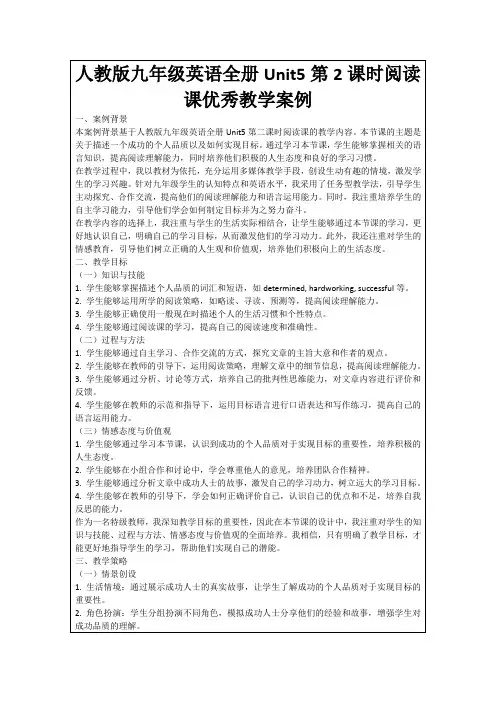
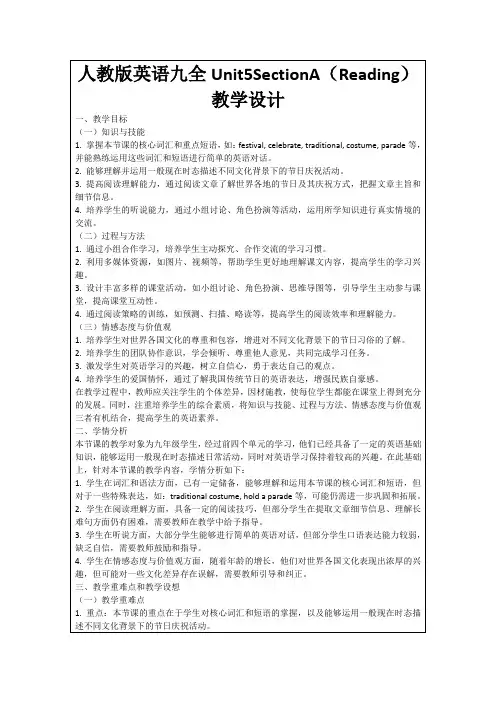
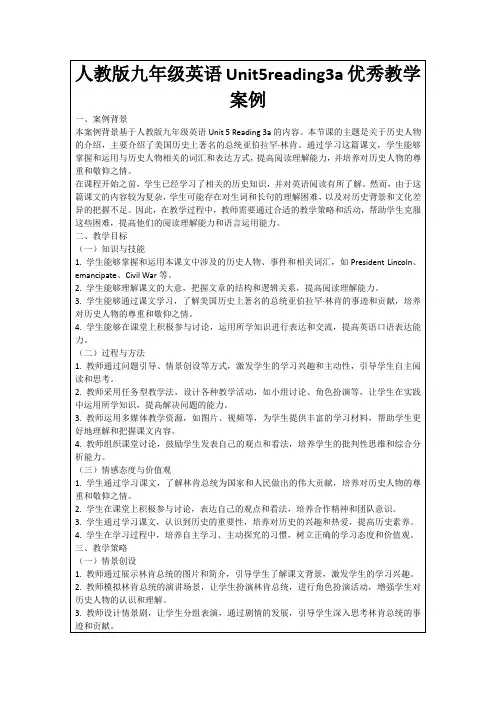
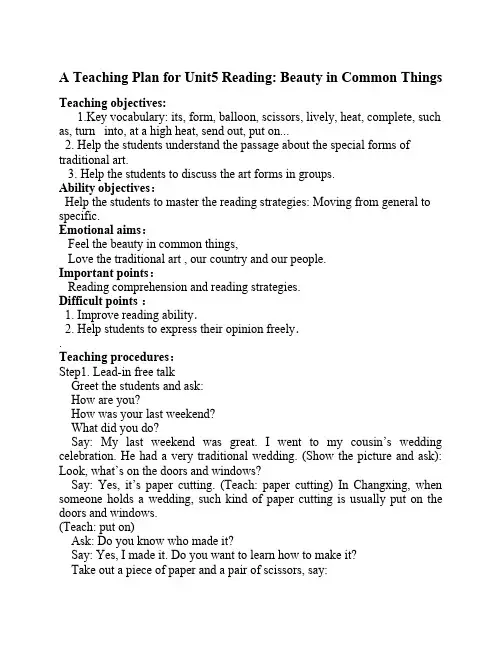
A Teaching Plan for Unit5 Reading: Beauty in Common Things Teaching objectives:1.Key vocabulary: its, form, balloon, scissors, lively, heat, complete, such as, turn into, at a high heat, send out, put on...2. Help the students understand the passage about the special forms of traditional art.3. Help the students to discuss the art forms in groups.Ability objectives:Help the students to master the reading strategies: Moving from general to specific.Emotional aims:Feel the beauty in common things,Love the traditional art , our country and our people.Important points:Reading comprehension and reading strategies.Difficult points :1. Improve reading ability.2. Help students to express their opinion freely..Teaching procedures:Step1. Lead-in free talkGreet the students and ask:How are you?How was your last weekend?What did you do?Say: My last weekend was great. I went to my cousin’s wedding celebration. He had a very traditional wedding. (Show the picture and ask): Look, what’s on the doors and windows?Say: Yes, it’s paper cutting. (Teach: paper cutting) In Changxing, when someone holds a wedding, such kind of paper cutting is usually put on the doors and windows.(Teach: put on)Ask: Do you know who made it?Say: Yes, I made it. Do you want to learn how to make it?Take out a piece of paper and a pair of scissors, say:OK. Let me tell you how to make it. You need a piece of red paper and a pair of scissors (Teach: scissors). First: fold the paper. Then cut it with the scissors. (Make the picture: xi )Step2. Pre-readingPredicting:Ask: Do you know when people began to put such paper cutting on doors and windows when they held a wedding?Say: Yes, maybe long long ago. So it is a form of traditional art. (Teach: form)Ask: Do you know any other traditional art forms like this?Say: Books open! We’ll read the passage on P38. First, look at the title and pictures, then predict:What the passage will mainly talk about?Ask: What’s the title? What’s in the pictures?What will the passage mainly talk about?Step3 While-readingTask1:Say: That’s good. Now let’s look through the whole passage and tell me: How many parts can the passage be divided into?Part 1(Para.1) A general introduction of Chinese traditional art Part 2(Paras2-4) Some examples and details of Chinese traditional art (Teach: clay)Good! You know some reading materials are usually moving from general to specific, That is: a general introduction is usually followed by specific details and examples. So when we do the reading, we should pay attention to that. Are you clear?Task2 Speed challenge1. Close reading:Say: OK, now let’s read the two parts more carefully, one by one. First, look at Para.1, it’s a general introduction of Chinese traditional art, right? Please read it and think about this question:What do we know about Chinese traditional art according to Para1? (Teach: turn into)2. Scanning:Say: You did very well. We’ve got the general introduction of Chinese traditional art. Let’s move on to the details and examples of them. ScanPara.2 to Para.4,and complete the chart:Common things Objects ofbeautySymbolsbamboo Sky lantern Happiness and good wishespaper Paper cutting Wishes for good luck and a happy newyearclay Chinese clay art Love for life and beautySay: Point to the first column and say things like bamboo, paper and clay are common things. Point to the third column and ask: But how about them? (They are beauty in life)Say: Yes. By making sky lanterns, paper cutting and clay art, the common things are turned into beauty. That is: these traditional art forms turn the common things into beauty.Ask: Which art form do you like best? Why?Task 3. Close readingPara2: Read and answer:Say: These art forms are really interesting, isn’t it? Do you want to know more about them? Now, let’s read the paragraphs in Part2 one by one. First, read Para.2, something about sky lanterns, and try to tell me some details about them.Ask:What do the sky lanterns look like? (Teach: balloon)Does it have the same meaning when people sent out sky lanterns in history and nowadays?So, let’s find the details in history, who and how?Who: Zhuge KongmingHow: asked for help.Say: Yes, according to a historical story, ( Teach: historical) Zhuge Kongming once was trapped by Sima Yi in a war. He was very clever, he made a lot of sky lanterns and sent them out to ask his friends for help, and he succeeded. (Teach: send out) But nowadays, what are they made of? When are they used? And why do people send the out?Who How in historyWhat When Why today2. Para3: Read and fill:Now, let’s move on to Para3, read carefully, and fill in the chart:Paper cutting History:The paper:The most common pictures: Where:Why:Ask: So why do people in Changxing put on paper cutting on doors and windows when they hold weddings?3. Para4:Now it’s time for Para.4. first, look at the picture and tell me:Are the children cute?Say: Yes. Chinese clay art pieces are usually from cute children and lively characters of Chinese fairy tales and historical stories. (Teach: lively, fairy) Now, please read it carefully and write “T” or “F”, and then correct the mistakes:1.The clay pieces are big and they look real.2.The pieces are shaped by hand.3.They are fired at a normal heat.4.The small pieces of clay art show the love that all Chinese people have for life and beauty.Say: Great! Look, what’s this? (clay) and what’s this?(a clay piece) How is the clay turned into clay piece? (Show the pictures and teach: heat )Get students to retell the steps of making a clay piece.Ask: How long does it take to complete a clay piece?(Teach: complete)Step4 : Post-reading:Say: You have done a very good job. Now please read the passage again quietly, and make yourself more familiar with the passage.Say: Today, we’ve talked something about some forms of Chinese traditional art. First, it’s a general introduction. It’s about how traditional artHappinessand good wishes Good luck anda happy new yearLove for year and beauty Bamboo and paper Paper Clayforms turn the common things into beauty. What are the common things? What specific traditional art forms? What specific beauty do they show? Step5 Discussion:China is a country with a long country. Besides these three traditional art forms, what else can you think of? What special meanings do they have? What common things are they made of? Discuss in groups of four.Step6 Homework:I must:Read the whole passage again.If I can:Search more information about Chinese traditional art on the internet. Blackboard design:Unit 5 ReadingBeauty in Common Thingssky lanternsTraditional paper cuttingart forms:Clay art。
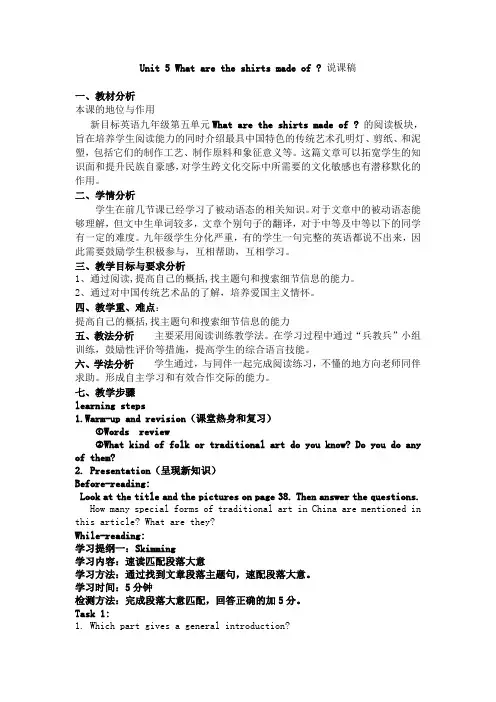
Unit 5 What are the shirts made of ?说课稿一、教材分析本课的地位与作用新目标英语九年级第五单元What are the shirts made of ?的阅读板块,旨在培养学生阅读能力的同时介绍最具中国特色的传统艺术孔明灯、剪纸、和泥塑,包括它们的制作工艺、制作原料和象征意义等。
这篇文章可以拓宽学生的知识面和提升民族自豪感,对学生跨文化交际中所需要的文化敏感也有潜移默化的作用。
二、学情分析学生在前几节课已经学习了被动语态的相关知识。
对于文章中的被动语态能够理解,但文中生单词较多,文章个别句子的翻译,对于中等及中等以下的同学有一定的难度。
九年级学生分化严重,有的学生一句完整的英语都说不出来,因此需要鼓励学生积极参与,互相帮助,互相学习。
三、教学目标与要求分析1、通过阅读,提高自己的概括,找主题句和搜索细节信息的能力。
2、通过对中国传统艺术品的了解,培养爱国主义情怀。
四、教学重、难点:提高自己的概括,找主题句和搜索细节信息的能力五、教法分析主要采用阅读训练教学法。
在学习过程中通过“兵教兵”小组训练,鼓励性评价等措施,提高学生的综合语言技能。
六、学法分析学生通过,与同伴一起完成阅读练习,不懂的地方向老师同伴求助。
形成自主学习和有效合作交际的能力。
七、教学步骤learning steps1.Warm-up and revision(课堂热身和复习)①Words review②What kind of folk or traditional art do you know? Do you do any of them?2. Presentation(呈现新知识)Before-reading:Look at the title and the pictures on page 38. Then answer the questions.How many special forms of traditional art in China are mentioned in this article? What are they?While-reading:学习提纲一:Skimming学习内容:速读匹配段落大意学习方法:通过找到文章段落主题句,速配段落大意。
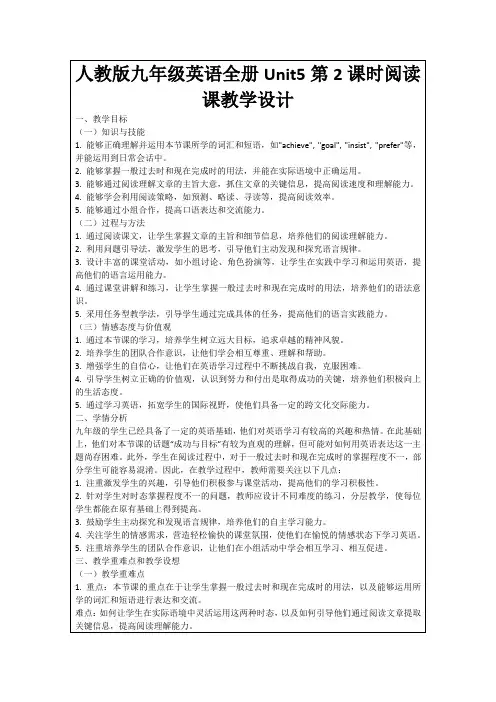
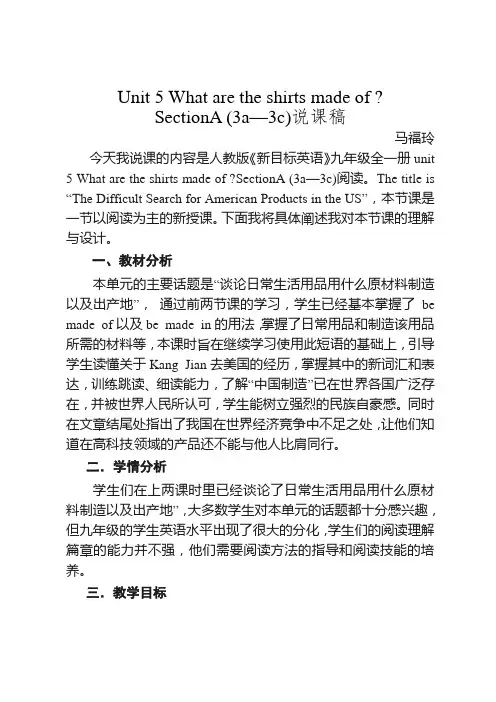
Unit 5 What are the shirts made of ?SectionA (3a—3c)说课稿马福玲今天我说课的内容是人教版《新目标英语》九年级全一册unit 5 What are the shirts made of ?SectionA (3a—3c)阅读。
The title is “The Difficult Search for American Products in the US”,本节课是一节以阅读为主的新授课。
下面我将具体阐述我对本节课的理解与设计。
一、教材分析本单元的主要话题是“谈论日常生活用品用什么原材料制造以及出产地”,通过前两节课的学习,学生已经基本掌握了be made of以及be made in的用法,掌握了日常用品和制造该用品所需的材料等,本课时旨在继续学习使用此短语的基础上,引导学生读懂关于Kang Jian去美国的经历,掌握其中的新词汇和表达,训练跳读、细读能力,了解“中国制造”已在世界各国广泛存在,并被世界人民所认可,学生能树立强烈的民族自豪感。
同时在文章结尾处指出了我国在世界经济竞争中不足之处,让他们知道在高科技领域的产品还不能与他人比肩同行。
二.学情分析学生们在上两课时里已经谈论了日常生活用品用什么原材料制造以及出产地”,大多数学生对本单元的话题都十分感兴趣,但九年级的学生英语水平出现了很大的分化,学生们的阅读理解篇章的能力并不强,他们需要阅读方法的指导和阅读技能的培养。
三.教学目标【知识目标】掌握P35的生词和短语:France,local,avoid,product,handbag,mobile,everyday等【教学重难点】熟练通过阅读策略,完成阅读任务。
了解中国制造在世界的影响力四.教法根据九年级学生现状,我主要采取了任务型教学法阅读前通过图片预测文章大意,阅读中设置阅读任务,深度理解文章内容。
其次视频导入法激发学生的学习兴趣,引入课文的学习。
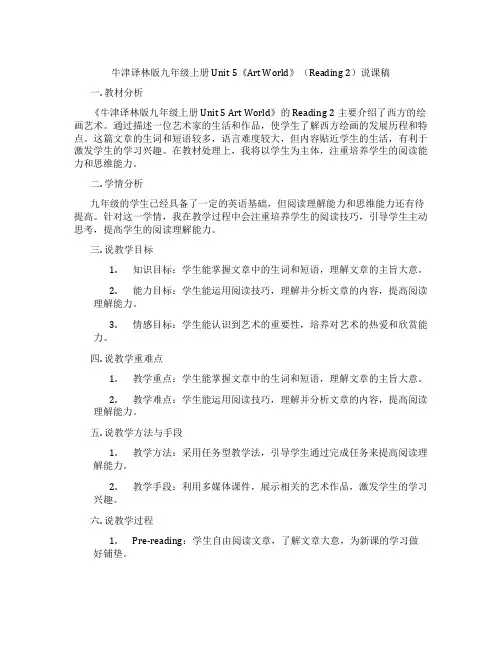
牛津译林版九年级上册Unit 5《Art World》(Reading 2)说课稿一. 教材分析《牛津译林版九年级上册Unit 5 Art World》的Reading 2主要介绍了西方的绘画艺术。
通过描述一位艺术家的生活和作品,使学生了解西方绘画的发展历程和特点。
这篇文章的生词和短语较多,语言难度较大,但内容贴近学生的生活,有利于激发学生的学习兴趣。
在教材处理上,我将以学生为主体,注重培养学生的阅读能力和思维能力。
二. 学情分析九年级的学生已经具备了一定的英语基础,但阅读理解能力和思维能力还有待提高。
针对这一学情,我在教学过程中会注重培养学生的阅读技巧,引导学生主动思考,提高学生的阅读理解能力。
三. 说教学目标1.知识目标:学生能掌握文章中的生词和短语,理解文章的主旨大意。
2.能力目标:学生能运用阅读技巧,理解并分析文章的内容,提高阅读理解能力。
3.情感目标:学生能认识到艺术的重要性,培养对艺术的热爱和欣赏能力。
四. 说教学重难点1.教学重点:学生能掌握文章中的生词和短语,理解文章的主旨大意。
2.教学难点:学生能运用阅读技巧,理解并分析文章的内容,提高阅读理解能力。
五. 说教学方法与手段1.教学方法:采用任务型教学法,引导学生通过完成任务来提高阅读理解能力。
2.教学手段:利用多媒体课件,展示相关的艺术作品,激发学生的学习兴趣。
六. 说教学过程1.Pre-reading:学生自由阅读文章,了解文章大意,为新课的学习做好铺垫。
2.While-reading:学生分组讨论,回答关于文章的问题,培养学生的合作意识。
3.Post-reading:学生进行角色扮演,模拟艺术家和生活,提高学生的口语表达能力。
七. 说板书设计板书设计主要包括文章标题、生词和短语、以及文章的主旨大意。
通过板书,帮助学生梳理文章内容,加深对文章的理解。
八. 说教学评价教学评价主要通过学生的课堂表现、作业完成情况和阅读理解测试来进行。
牛津上海版英语九年级下册《Unit 5 A story by Mark Twn》说课稿1一. 教材分析《Unit 5 A story by Mark Twn》是牛津上海版英语九年级下册的一篇课文。
本课主要讲述了美国著名作家马克·吐温的一个故事,通过故事使学生了解并感受马克·吐温的作品风格,同时提高学生的阅读理解能力。
教材内容丰富,语言生动有趣,贴近学生生活,有助于激发学生的学习兴趣。
二. 学情分析九年级的学生已经具备了一定的英语基础,能够理解和运用基本的英语语法和词汇。
但他们在阅读理解方面还存在一定的困难,特别是对于长篇阅读材料,可能会感到迷茫。
因此,在教学过程中,需要帮助学生分析文章结构,提高阅读理解能力。
此外,学生对于外国文化还较为陌生,需要通过教材内容来逐渐拓宽视野。
三. 说教学目标1.知识目标:让学生掌握文章中的重点单词和短语,理解文章的基本内容。
2.能力目标:提高学生的阅读理解能力,能够概括文章大意,分析文章结构。
3.情感目标:培养学生对马克·吐温作品的兴趣,感受外国文化的魅力。
四. 说教学重难点1.重点:文章中的重点单词和短语,以及马克·吐温的作品风格。
2.难点:理解文章的深层含义,分析文章结构,提高阅读理解能力。
五. 说教学方法与手段1.教学方法:采用问题驱动法、情景教学法、分组讨论法等,激发学生的学习兴趣,提高学生的参与度。
2.教学手段:利用多媒体课件、图片、视频等辅助教学,帮助学生更好地理解文章内容。
六. 说教学过程1.导入:通过展示马克·吐温的图片和简介,引出本课主题,激发学生的兴趣。
2.阅读理解:让学生独立阅读课文,回答相关问题,检测学生的阅读理解能力。
3.词汇学习:分析文章中的重点单词和短语,让学生通过语境理解词汇含义。
4.文章分析:引导学生分析文章结构,概括文章大意,提高学生的阅读分析能力。
5.分组讨论:让学生分组讨论文章的深层含义,培养学生的合作精神和口头表达能力。
仁爱版九年级下册英语Unit 5说课稿一,说教材1,教材地位:本单元教学内容主要围绕中国地理和历史方面的话题展开,是对上个单元FantasticScience的承接与发展,是《英语课程标准》规定的基础教育阶段的主要任务之一(即帮助学生了解世界和中西方文化的差异,拓展视野,培养爱国主义精神,形成健康的人生观)。
本单元的四组并列连词与定语从句在八年级(下)的九年级(上)教材中曾多次出现过,在本单元进行归纳,由此,本单元在整个教材中占有重要地位。
2,教材结构:本单元分三个话题:第一个话题It attractslots of tourists from China and abroad every year,介绍了中国的风景名胜;学习由that和which引导的定语从句。
第二个话题China has a long and great history介绍一些中国历史上的著名人物,及他们同时期的历史事件;学习由who,whom和whose引导的定语从句。
第三部分WhatdoyouknowaboutChina’sculture?则是以谈论中国古代文化为主,重点介绍了中国古代建筑,如故宫,华表等,中国象棋和中国古代四大发明。
本话题归纳总结了并列连词either...or...,bothonly...but also...的用法。
...and...,neither...nor...,not3,教学目标:(1)语言知识:①本单元共出现93个新单词,考虑到学生实际情况,我只要求他们掌握以下23个《英语课程标准》要求掌握的词:(按词性分类,方便记忆)名词:tourist,well,bridge,heaven,island,state,coast,army,march,enemy,chairman,prize,pro mise,tower,chess,memory,discovery,rope,physics动词:fetch, introduce动词兼名词:experience名词兼形容词:plain, total②掌握以下13个短语:lie in,be (well) worthdoing...,assoonaspossible,beknownas,breakdown,wayoflife,intotal,wipeout,succeedi ndoing...,bringdown,passaway,breakout,in memory of③掌握并列连词either...or...,both...and...,neither...nor...,notonly...butalso...的用法;掌握由that,which,who,whom及whose引导的定语从句。
牛津译林版九年级上册英语Unit5-Unit6复习说课稿一. 教材分析牛津译林版九年级上册英语Unit5-Unit6,包括两个单元的内容。
Unit5的主题是“The Great Wall”,主要介绍中国的长城,以及与之相关的历史和文化。
Unit6的主题是" Protecting ourselves",主要讲述如何保护自己,包括交通安全,网络安全等方面。
这两个单元的内容丰富,贴近学生的生活,有利于激发学生的学习兴趣。
二. 学情分析九年级的学生已经有一定的英语基础,对于一些基本的语法和词汇已经有所了解。
但是,他们在阅读长篇文章,尤其是涉及到文化背景的文章时,可能会遇到一些困难。
此外,九年级的学生正处于青春期,对于一些与自我保护相关的话题可能会比较感兴趣。
三. 说教学目标1.知识目标:学生能够掌握Unit5-Unit6中的基本词汇和语法结构。
2.能力目标:学生能够阅读并理解与Unit5-Unit6相关的话题文章,能够用英语进行简单的交流和讨论。
3.情感目标:通过学习Unit5-Unit6,学生能够增强自我保护意识,提高自我保护能力。
四. 说教学重难点1.教学重点:Unit5-Unit6中的基本词汇和语法结构。
2.教学难点:理解并运用Unit5-Unit6中的词汇和语法结构进行阅读和交流。
五. 说教学方法与手段1.教学方法:采用任务型教学法,让学生在完成任务的过程中,自然地学习和运用英语。
2.教学手段:利用多媒体教学,如图片,视频等,帮助学生更好地理解和学习英语。
六. 说教学过程1.引入:通过展示长城的图片,引导学生谈论长城,引入Unit5的学习。
2.新课导入:通过讲解和练习,让学生掌握Unit5-Unit6中的基本词汇和语法结构。
3.阅读理解:通过阅读与Unit5-Unit6相关的话题文章,提高学生的阅读理解能力。
4.小组讨论:学生分组讨论,运用Unit5-Unit6中的词汇和语法结构进行交流。
初中英语九年级 Unit 5 Section A (2a-2d)说课稿一. 教材分析《初中英语九年级 Unit 5 Section A (2a-2d)》是人教版初中英语教材九年级上册的一篇文章,主要讲述了关于环保的话题。
通过本节课的学习,学生将能够了解到不同国家在环保方面的做法,提高自己的环保意识,并学会如何在生活中保护环境。
本节课的主要语言知识点包括一般现在时态的被动语态、常用环保词汇和短语的运用等。
二. 学情分析九年级的学生已经具备了一定的英语基础,能够听懂并运用一般现在时态描述事情。
但是,对于一般现在时态的被动语态和环保相关词汇的运用还需加强。
此外,学生对于环保这个话题有一定的了解,但需要通过本节课的学习,进一步提高自己的环保意识。
三. 说教学目标1.知识目标:学生能够掌握一般现在时态的被动语态,并能运用所学词汇和短语描述不同国家在环保方面的做法。
2.能力目标:学生能够通过阅读和听力理解,提高自己的英语综合运用能力。
3.情感目标:学生能够增强环保意识,认识到保护环境的重要性,并在生活中付诸实践。
四. 说教学重难点1.重点:学生能够掌握一般现在时态的被动语态,并能运用所学词汇和短语描述不同国家在环保方面的做法。
2.难点:学生能够正确运用一般现在时态的被动语态,并在实际情景中灵活运用。
五. 说教学方法与手段1.教学方法:采用任务型教学法,让学生在完成任务的过程中,掌握语言知识和提高语言运用能力。
2.教学手段:利用多媒体课件、图片、卡片等辅助教学,激发学生的学习兴趣,提高课堂效果。
六. 说教学过程1.导入:教师通过展示一些环保的图片,引导学生谈论环保话题,并导入本节课的主题。
2.读前预测:教师引导学生根据文章标题和图片,预测文章内容,激发学生的阅读兴趣。
3.读中活动:教师学生分角色朗读课文,引导学生关注一般现在时态的被动语态和环保相关词汇。
4.读后活动:教师学生进行小组讨论,让学生运用所学知识,描述不同国家在环保方面的做法。
Unit 5 What are the shirts made of ?说课稿
一、教材分析
本课的地位与作用
新目标英语九年级第五单元What are the shirts made of ?的阅读板块,旨在培养学生阅读能力的同时介绍最具中国特色的传统艺术孔明灯、剪纸、和泥塑,包括它们的制作工艺、制作原料和象征意义等。
这篇文章可以拓宽学生的知识面和提升民族自豪感,对学生跨文化交际中所需要的文化敏感也有潜移默化的作用。
二、学情分析
学生在前几节课已经学习了被动语态的相关知识。
对于文章中的被动语态能够理解,但文中生单词较多,文章个别句子的翻译,对于中等及中等以下的同学有一定的难度。
九年级学生分化严重,有的学生一句完整的英语都说不出来,因此需要鼓励学生积极参与,互相帮助,互相学习。
三、教学目标与要求分析
1、通过阅读,提高自己的概括,找主题句和搜索细节信息的能力。
2、通过对中国传统艺术品的了解,培养爱国主义情怀。
四、教学重、难点:
提高自己的概括,找主题句和搜索细节信息的能力
五、教法分析主要采用阅读训练教学法。
在学习过程中通过“兵教兵”小组训练,鼓励性评价等措施,提高学生的综合语言技能。
六、学法分析学生通过,与同伴一起完成阅读练习,不懂的地方向老师同伴求助。
形成自主学习和有效合作交际的能力。
七、教学步骤
learning steps
1.Warm-up and revision(课堂热身和复习)
①Words review
②What kind of folk or traditional art do you know? Do you do any of them?
2. Presentation(呈现新知识)
Before-reading:
Look at the title and the pictures on page 38. Then answer the questions.
How many special forms of traditional art in China are mentioned in this article? What are they?
While-reading:
学习提纲一:Skimming
学习内容:速读匹配段落大意
学习方法:通过找到文章段落主题句,速配段落大意。
学习时间:5分钟
检测方法:完成段落大意匹配,回答正确的加5分。
Task 1:
1. Which part gives a general introduction?
2. Where can you find specific information?
Task 2: 将下列自然段与段落大意进行匹配(以极快的速度阅读短文,总结每Paragraph 1 Paragraph 2 Paragraph 3 Paragraph 4
学习提纲二Scanning
学习内容:细读文章,完成练习
学习方法:通过仔细读问题,找到关键词定位答案所在段落,仔细阅读文章,完成练习。
学习时间:20分钟
检测方法:完成各个段落相关练习,回答正确加5分。
Task 1: 2b Read the passage and complete the chart below . Traditional art form Materials used Symbolic meaning
sky lanterns
paper cutting
Chinese clay art
Task 2:2c Read carefully and answer the questions.
1. What do traditional Chinese art forms try to show?
2. What were sky lanterns used for before and what are they used for now?
3. What kind of pictures are usually found on paper cutting?
4. How do people use paper cutting during the Spring Festival?
5. What are the steps for making clay art pieces?
Task 3:Read Paragraph 2 and answer the questions.. Finish the mind map.
Task 4:Read Paragraph 3 and fill in the blanks.
Paper cutting has been around for over 1,500 years. Each different part of China has its own special forms of traditional art. Chinese clay art is famous because the clay pieces are so small but they look very real. According to Chinese history, sky lanterns were first used by Zhuge Kongming.
Paper cutting has been ________for over 1,500 years. It is ________ to do paper cutting. The paper _________ before it ______ with scissors. Then the paper was ________ flowers, animals, and things about Chinese history. They’re the ________ of wishes for good luck and a happy new year.
Task 5: Read paragraph 4 and put the steps for making clay art pieces in order.
_____ allowed to air-dry
_____ they are then polished and painted
_____ shaped by hand from a very special kind of clay
_____ fired at a very high heat
Post-reading:
Complete the sentences using the correct forms of the phrases in the box.
1. People used to __________ sky lanterns when they were in trouble. But today, people light the lanterns and watch them ____________ the sky with their wishes .
2. The art of paper cutting _______ a simple thing like a piece of paper __________ a beautiful piece of art. People often __________these art pieces _______ the doors, the windows and walls of their homes to celebrate the Spring Festival.
3. To make Chinese clay art, the clay is shaped by hand into things ____________ cute children or characters from Chinese fairy tales and stories. They are then ____________ paint.
Summary
你今天学习到了什么样的阅读策略?
如何快速找到文章和文章段落的大意?
Homework
上网查阅现存有关中国传统非物质文化遗产现状,分享给大家。
教后记
教学反思:
环节之间不够紧凑,上课状态太放松,没有控制好时间,教学任务没有完成,同时,中间一些可以让学生总结的东西,我都代替学生说了出来,可以发挥学生的主动性,让学生总结。